Bone regenerative medicine: classic options, novel strategies, and future directions
- PMID: 24628910
- PMCID: PMC3995444
- DOI: 10.1186/1749-799X-9-18
Bone regenerative medicine: classic options, novel strategies, and future directions
Abstract
This review analyzes the literature of bone grafts and introduces tissue engineering as a strategy in this field of orthopedic surgery. We evaluated articles concerning bone grafts; analyzed characteristics, advantages, and limitations of the grafts; and provided explanations about bone-tissue engineering technologies. Many bone grafting materials are available to enhance bone healing and regeneration, from bone autografts to graft substitutes; they can be used alone or in combination. Autografts are the gold standard for this purpose, since they provide osteogenic cells, osteoinductive growth factors, and an osteoconductive scaffold, all essential for new bone growth. Autografts carry the limitations of morbidity at the harvesting site and limited availability. Allografts and xenografts carry the risk of disease transmission and rejection. Tissue engineering is a new and developing option that had been introduced to reduce limitations of bone grafts and improve the healing processes of the bone fractures and defects. The combined use of scaffolds, healing promoting factors, together with gene therapy, and, more recently, three-dimensional printing of tissue-engineered constructs may open new insights in the near future.
Figures



References
-
- Nandi SK, Roy S, Mukherjee P, Kundu B, De DK, Basu D. Orthopaedic applications of bone graft and graft substitutes: a review. Indian J Med Res. 2010;132:15–30. - PubMed
-
- Bigham AS, Dehghani SN, Shafiei Z, Torabi Nezhad S. Xenogenic demineralized bone matrix and fresh autogenous cortical bone effects on experimental bone healing: radiological, histopathological and biomechanical evaluation. J Orthop Traumatol. 2008;9:73–80. doi: 10.1007/s10195-008-0006-6. - DOI - PMC - PubMed
-
- Hegde C, Shetty V, Wasnik S, Ahammed I, Shetty V. Use of bone graft substitute in the treatment for distal radius fractures in elderly. Eur J Orthop Surg Traumatol. 2012. doi:10.1007/s00590-012-1057-1. - PubMed
Publication types
MeSH terms
Substances
LinkOut - more resources
Full Text Sources
Other Literature Sources

